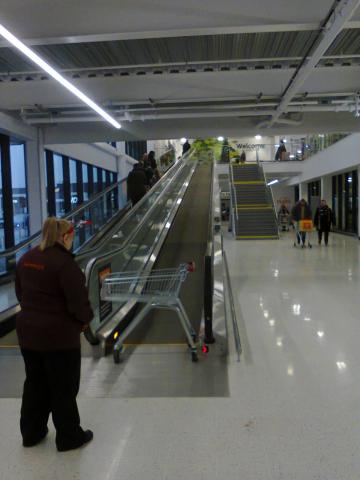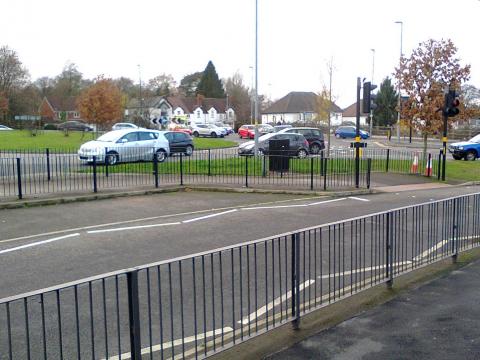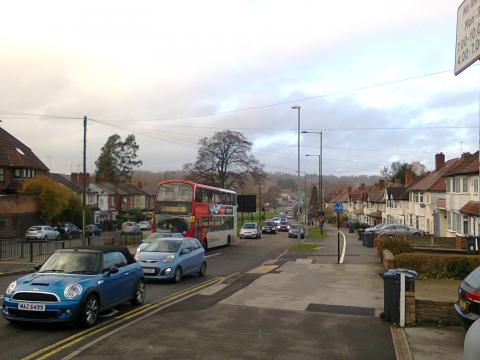
In the last century "futurologists" quite often predicted that in the future (ie now) we would all be travelling everywhere in "atom power" cars that looked suspiciously like 1950s cars with jet-age additions, and pedestrians would be whisked along on aerial travelators. Of course it wasn't long before the ideas looked laughable. Travelators require power and maintenance, so their widespread use, especially out in the open, was never very likely. Cars powered by dangerous materials that require specialist handling and disposal were even more unlikely, but whilst they remained an absurd flight of fantasy, the idea that we would drive everywhere was taken seriously. Creating these automotive cities required buildings to be demolished to make way for dual carriageways and bloated road junctions, or concrete flyovers were built over the top of whatever was considered to be an impediment to "progress". But rather than being provided with impractical aerial travelators, pedestrians were sent underground through tortuous subways that thanks to blind corners doubled as mugging zones and gentlemen's lavatories. Sound familiar? Yes, Birmingham was rebuilt as an automotive city, and we can all see for ourselves the miserable, ugly, polluted and traffic-congested environment that is an automotive city.
There were a few attempts at aerial walkways, but just like their underground equivalent they were a failure. Constantly ascending to and descending from the walkways via flights of steps gets quickly tedious, and people stop doing it unless they are provided with powered assistance in the form of lifts and escalators. These became essential once we realised that some people are simply unable to climb flights of steps. Unfortunately they require power and maintenance, as would the travelators had they ever materialised.
A little thought, helped with a dose of hindsight, reveals these ideas from the last century to be totally impractical. That was quickly realised in some parts of the world, and the automotive city was dropped in favour of better ideas; the Dutch opted for the bicycle. Alas in the UK, whilst there have been some reversals of automotive city designs, they have tended to be very incomplete, and there is huge reluctance to learn from their success. Instead we see the opposite.
Selly Oak is a great demonstration of the result of automotive city planning. The town centre is almost completely dead, destroyed by a large, polluted traffic junction, where crossing the road or riding a bike is at best difficult, and at worst dangerous. The council talks about making it a Green Travel District, but what is appearing in Selly Oak is apparently modelled on the automotive city visualisation shown at the top of the page. Of course the buses don't have tail fins, and the cars don't look suspiciously like they were designed in 1952 (or tank-up with uranium), but otherwise it's the same. There are even travelators.
The new shops being built in Selly Oak are all on the road that should have been a bypass, and large car parks separate them from the road. In his 1989 book "The Lost Continent", Bill Bryson describes something identical, but in America, and how its design makes walking difficult. If using anything other than a car is difficult, people will drive, with all the problems that flow from that. It makes no difference how many times this mistake is repeated, it will always be a mistake. So it's no surprise that there are huge traffic jams resulting from people queuing to get in and out of the massive car park that separates the road from the store fronts. Inside the car park staff were deployed to control the traffic, whilst outside on the road that should have been a bypass, drivers sit and stew and blow their horns. Those jams extend down Harborne Lane as far as the eye can see.
 To make space for the car park the Sainsbury's store itself has been raised above the ground. That means to get in and out of the supermarket there is a flight of stairs, lifts, and a travelator. Unfortunately the narrow travelator hardly "whisks" pedestrians in an out of the store; it is painfully slow and trolleys become magically braked, making it impossible to speed things up a bit by walking along the travelator. If that were not bad enough, the travelators have broken down several times since the supermarket opened, necessitating either using the stairs, or a long detour and a queue for the lifts, whilst a member of staff wastes their life ensuring no-one uses the stationary travelator. Of course when they're working the travelators and lifts burn their way through electricity all the time the store is open, electricity that is mostly generated by burning fossil fuels.
To make space for the car park the Sainsbury's store itself has been raised above the ground. That means to get in and out of the supermarket there is a flight of stairs, lifts, and a travelator. Unfortunately the narrow travelator hardly "whisks" pedestrians in an out of the store; it is painfully slow and trolleys become magically braked, making it impossible to speed things up a bit by walking along the travelator. If that were not bad enough, the travelators have broken down several times since the supermarket opened, necessitating either using the stairs, or a long detour and a queue for the lifts, whilst a member of staff wastes their life ensuring no-one uses the stationary travelator. Of course when they're working the travelators and lifts burn their way through electricity all the time the store is open, electricity that is mostly generated by burning fossil fuels.
Almost nothing has been provided to help people get around Selly Oak by means other than by car. The only connection between the Sainsbury's retail park, Homebase, the Battery retail park, and the high street is a very narrow pavement alongside several lanes of stationary traffic that fills the air with fumes that have at times broken the EU limits for nitrogen dioxide (there is supposed to be a link between the retail park and the high street, but it has yet to be built). Unbelievably, part of that pavement has been divided into two, creating a bidirectional cycle path that is only wide enough for one bike at best, but which is in places partially blocked by road signs, posts, and railings. The permanent road signs are sometimes supplemented with temporary road signs that completely block the cycleway. People travelling on foot or bike have to cross the road using multi-stage toucan crossings with awkward, extremely tight turns. Despite being treated as second-class citizens compared with people who drive, many people are choosing to walk and cycle to the new retail park, completely overloading the grossly substandard infrastructure provided. Muddy tracks have appeared, and there is conflict between people on bikes and on foot.
Does this look like encouraging green travel to you?
The car park has spaces for about 850 cars, but there are only about a dozen cycle stands. Half are near the entrance to the retail park (making them inconvenient for most of the shops), and are reached by a three stage toucan crossing and a zebra crossing. The other half are outside Sainsbury's and are accessed by abusing a zebra crossing and cycling through the car park past all the queuing cars. Pedestrians face a lengthy walk across the car park, a walk they have already shortened. One muddy desire line runs between the road and the petrol station. Two more pass from the old canal bridge down to a walkway that ends at the bridge. This walkway was supposed to run alongside the reconstructed Dudley No 2 canal, but all that has been dug is a shallow ditch.
On the positive side the cycle stands are all covered, and those outside Sainsbury's are right by the front door. Unfortunately they are of a curved design that only supports your bike properly if you lock the rear of the bike to the straight part, but the racks are too close to the wall to do that (Update: now fixed, following complaints by Push Bikes members). This results in your bike falling over when you attach the panniers. And since there is no trolley park by the front door, the bike stands double as a trolley park.
 |
 |
 |
| When I took this photo I wanted to buy something from Poundland, but a huge wall blocks the way, and the detour for people cycling or on foot is lengthy, awkward and unpleasant, so I didn't bother. Automotive city design kills trade. | People arriving by car at this brand new development get multiple lanes, whilst pedestrians and cyclists are jammed on to a narrow, bumpy path that they share with street lamps, road signs, railings, and utility boxes. | Finding the walking and cycling infrastructure unfit for purpose, people are creating their own paths. Desire lines such as this are a sure sign the design is wrong. |
It has been known for many years now that if you build a road that bypasses a town centre, and then build a retail park on that bypass, you simply move all the trade and the traffic problems to the bypass, solving nothing. That Birmingham City Council carefully avoid calling the Selly Oak new road a bypass is irrelevant. The mistake has been repeated, so the "bypass" is jammed with traffic, and new shop units on Selly Oak high street remain unlet.
All the mistakes that have been made here have been made before, and have been known about for decades. What are we supposed to make of designers who simply repeat the same well-known errors over and over again? As for the Green Travel District in Selly Oak, this outdated automotive city retail park, with its heavy reliance by design on powered transport (mostly in the form of private cars), is the complete antithesis of a real green travel district. The Selly Oak Green Travel District is already dead in the water.
What You Can Do
Email your local councillor, especially if they represent the Selly Oak area, and ask them why the City Council is not delivering the Selly Oak Green Travel District. Ask them what they will do about it.





